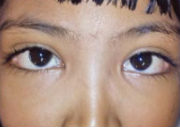Carbonic anhydrase catalyses the first part of the reversible reaction in which carbon dioxide and water are converted to carbonic acid (and vice versa):
CO2 + H2O ←→ H+ + HCO3-
In the kidney, carbonic anhydrase is found in the proximal convoluted tubule.
The equation is normally shifted to the left allowing the formed carbon dioxide to diffuse back into the systemic circulation. In the presence of a carbonic anhydrase inhibitor, such as acetazolamide, the equation is shifted to the right and more H+ and HCO3- is produced. The H+ is reabsorbed alongside chloride ions. However, the bicarbonate is passed in the urine as it is not easily absorbed in the nephron. This results in a hyperchloraemic, normal anion gap metabolic acidosis.
This effect can be used therapeutically to prevent acute mountain sickness. Whereas normally the hypoxic high altitude would stimulate ventilation resulting in a respiratory alkalosis, acetazolamide use causes net renal excretion of bicarbonate, correcting this abnormality.
With respiratory alkalosis the kidneys would physiologically excrete bicarbonate, but this takes two to three days. Acetazolamide speeds this process.
The anion gap is a simple method for discerning causes of metabolic acidosis. It relies on the fact that the concentration of cations in a solution (that is, plasma) must equal the concentration of anions. Cations have positive charge, anions have negative charge.
[Cations] = [Anions]
Most ions are unmeasured and individually have a low concentration. The measured ions in sufficient concentration are sodium, potassium, chloride and bicarbonate.
Therefore:
[Na] + [K] + [unmeasured cations] = [Cl] + [HCO3] [unmeasured anions]
And rearranging:
([Na] + [K]) - ([Cl] + [HCO3]) = [unmeasured anions] - [unmeasured cations].
In health the difference between unmeasured anions and unmeasured cations, known as the anion gap, is between 10-18 mmol/l. This value is helpful in discerning causes of metabolic acidosis, as if it is raised the acidosis is due to an unmeasured ion - such as lactate, ketones, salicylate in lactic acidosis, diabetic ketoacidosis and aspirin overdose respectively.
A normal anion gap suggests an acidosis due to bicarbonate or chloride handling - such as renal tubular acidosis, diarrhoea, ammonium chloride ingestion or, in this case, acetazolamide.
Acetazolamide is a carbonic anhydrase inhibitor which may result in a metabolic acidosis. This is not the result of an increase of unmeasured anion so therefore results in a normal anion gap. Therefore it is the best answer in this case. Other causes of a metabolic acidosis with normal anion gap are renal tubular acidosis, diarrhoea, pancreatic fistula and chloric acid (such as ammonium chloride) ingestion.
A metabolic acidosis with raised anion gap occurs in the setting of an additional unmeasured anion.
This occurs in lactic acidosis, diabetic ketoacidosis, aspirin overdose and methanol or ethylene glycol poisoning.
A metabolic alkalosis may be seen in vomiting, from other diuretics or excessive bicarbonate or antacid therapy.
Respiratory acidosis is defined by a raised pCO2 and is typically related to type 2 respiratory failure. It is seen in severe COPD, asthma, pneumonia or pulmonary oedema and hypoventilation due to sedatives, muscular disease (for example, myasthenia gravis) or chest wall trauma.
Respiratory alkalosis is seen in any cause of hyperventilation, either due to anxiety, or in hypoxic states such as asthma where adequate ventilation is preserved.




























